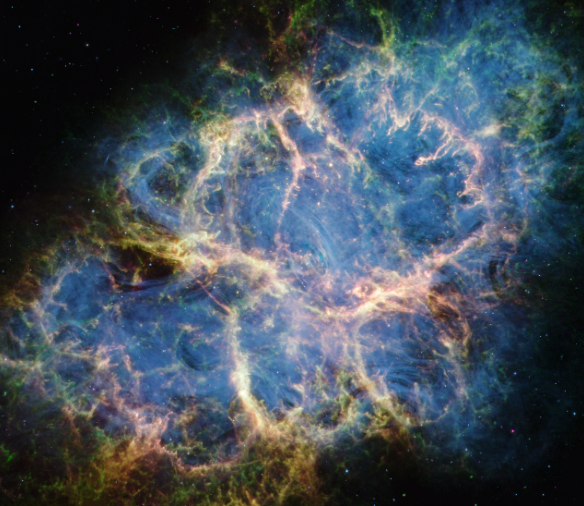Scientists using NASA's James Webb Space Telescope are eager to crack open cosmic crab meat. They have comprehensively analyzed the Crab Nebula, a supernova remnant located 6,500 light-years away in the constellation Taurus.
Equipped with the telescope's MIRI (Mid-Infrared Instrument) and NIRCam (Near-Infrared Camera), the team has gathered crucial data to shed light on the nebula's composition and its enigmatic past.

NASA: Cracking Open the Crab Nebula
The Crab Nebula originated from a core-collapse supernova resulting from a massive star's demise. The supernova explosion, seen on Earth in 1054 CE, was notably bright to be visible during daylight hours.
This celestial object remains peculiar due to its atypical composition and remarkably low explosion energy, characteristics previously attributed to an electron-capture supernova.
This rare explosion arises from a star with an underdeveloped core primarily composed of oxygen, neon, and magnesium, unlike the typical iron core. However, the recent data from Webb expands the scope of interpretations regarding the nebula's composition.
Tea Temim, the study's lead author from Princeton University, noted that the composition of the nebula's gas may not necessarily point to an electron-capture event but could also align with a low-energy iron core-collapse supernova.
Previous studies have attempted to determine the explosion's total energy based on the current ejecta's quantity and velocities. Astronomers believe the explosion was relatively low in energy, less than a typical supernova.
According to NASA, this indicates a progenitor star with a mass hovering between eight and ten solar masses. Despite this, discrepancies persist between observations of the Crab Nebula, particularly the pulsar's rapid motion, and the electron-capture supernova theory.
Recent advancements in understanding iron core-collapse supernovae suggest that these events can also result in low-energy explosions under specific conditions of low stellar mass.
To minimize uncertainties about the nebula's progenitor star and the nature of its explosion, Temim's team leveraged Webb's spectroscopic capabilities to focus on specific regions within the nebula's inner filaments. They scrutinized the nickel-to-iron (Ni/Fe) abundance ratio, crucial in distinguishing between different types of supernovae.
Electron-Capture Supernova
NASA noted that previous studies in the late 1980s and early 1990s suggested a high Ni/Fe ratio within the Crab, indicative of an electron-capture supernova.
However, Webb's infrared sensitivity provided a more refined estimate, indicating a modestly elevated ratio compared to solar abundances, supporting but not conclusively proving the electron-capture scenario.
The telescope not only extracted spectral data from two small regions within the Crab Nebula to measure abundance ratios but also surveyed its broader surroundings.
This enabled a detailed study of synchrotron emission and dust distribution. Using images and data from MIRI, researchers isolated and mapped dust emission within the Crab with unprecedented clarity.
Combining Webb's observations of warm dust with Herschel Space Observatory's data on cooler grains provided a comprehensive view: Warmer dust is prevalent in outer filaments, while cooler grains are concentrated nearer the center.
Nathan Smith, from the Steward Observatory at the University of Arizona and a co-author of the paper, finds the distribution of dust within the Crab Nebula intriguing because it differs from that of other supernova remnants, such as Cassiopeia A and Supernova 1987A.
"The Crab Nebula lives up to a tradition in astronomy: The nearest, brightest, and best-studied objects tend to be bizarre," Smith said in a statement.
The findings were published in The Astrophysical Journal Letters.
Related Article : NASA James Webb Space Telescope Dives into an Extreme Starburst Galaxy

ⓒ 2025 TECHTIMES.com All rights reserved. Do not reproduce without permission.




